All’inizio della primavera e dell’autunno i cinesi, giovani e anziani, si recano all’esterno per far volare aquiloni di carta che, con la loro solita fantasia eccentrica, costruiscono in ogni sorta di forme grottesche: draghi, insetti, figure e altre forme.
A volte fissano agli aquiloni delle piccole lanterne, in modo che di notte presentino un aspetto molto brillante.
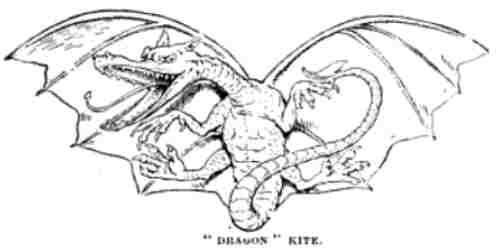
Kites have played a not unimportant part in various millitary matters, having occasionally been employed to convey signals or to carry ropes to a certain height; and every school-boy has heard la story of Dr. Franklin and his electrical kite.
Gli aquiloni hanno svolto un ruolo non trascurabile in varie questioni militari, essendo stati occasionalmente impiegati per trasmettere segnali o per trasportare corde ad una certa altezza; e ogni scolaro ha sentito la storia del dottor Franklin e del suo aquilone elettrico.
For the proper construction of a kite that will aspire to a soaring, upward flight, straight, smooth lath, about three-eights of an inch thick and one and a half broad, and some cane -willow or bamboo – are needed; also strong, fine twine, and whatever the kite is to be clothed eith, – paper, cloth, cambric, or silk.
Per la corretta costruzione di un aquilone che aspiri al volo verso l’alto, sono necessari listelli diritti e lisci, spessi circa tre ottavi di pollice e larghi uno e mezzo, e qualche canna – di salice o bambù; – inoltre spago forte e fine e qualunque cosa l’aquilone debba essere vestito: carta, stoffa, cambrì (cotone) o seta.
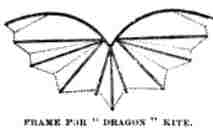
The designs we give are not difficult for anyone to make of the simple materials required.
I disegni che forniamo non sono difficili per nessuno da realizzare con i semplici materiali richiesti.
In nearly every instance the frame isillustred separately, showing how the cane is to be bent and the cord tied to give the proper shape. The proportions as show be followed, in order to preserve the balance; but the kites can be made of any size under six feet in height, for the frame.
In quasi tutti i casi il telaio è illustrato separatamente, mostrando come piegare la canna e legare la corda per dare la forma corretta. Vanno rispettate le proporzioni indicate, per preservarne l’equilibrio; ma gli aquiloni possono essere realizzati di qualsiasi dimensione inferiore a sei piedi di altezza, per il telaio.
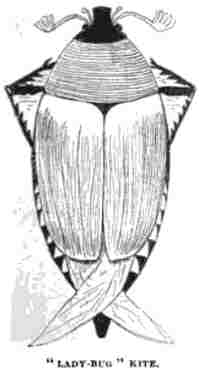
In these faciful designs for kites, a medium size – about a yard at tje longest part! – will probably be the most satisfactory, as there is less to lose if, as happened to Johnny White’s kite, it should have its tail broken and fly away. By the way. Chinese kites have no tails; but they are constructed of such light materials as to need little steadying, and the snake-kites are tail and head.
In questi fantastici modelli di aquiloni, una dimensione media – circa un metro nella parte più lunga! – sarà probabilmente la più soddisfacente, perché c’è meno da perdere se, come è successo all’aquilone di Johnny White, dovesse rompersi la coda e volare via. A proposito. Gli aquiloni cinesi non hanno coda; ma sono costruiti con materiali così leggeri da richiedere poco sostegno, e gli aquiloni-serpenti sono coda e testa.
To make the bamboo or cane pliable so that it can be bent in any shape required, it must be soaked for a time in soapy water. In all the frames illustrated, the dotted lines represent stout twine fastened securely at each part of the frame. The designs for the frames also show where the canes are to be crossed, bent, and tied together. In all cases, a twine should complete the outline of the whole frame. To cover the kites, take large-sized sheets of paper, and lay them over the frame-work so as to cover all one side of the kite.
Per rendere il bambù o la canna malleabile, in modo che possa essere piegato in qualsiasi forma richiesta, è necessario immergerlo per un certo periodo in acqua saponata. In tutti i telai illustrati, le linee tratteggiate rappresentano uno spago robusto fissato saldamente in ogni parte del telaio. I disegni dei telai mostrano anche dove le canne devono essere incrociate, piegate e legate insieme. In tutti i casi, lo spago deve completare il contorno dell’intera cornice. Per coprire gli aquiloni, prendete dei fogli di carta di grandi dimensioni e stendeteli sul telaio in modo da coprire tutto un lato dell’aquilone.
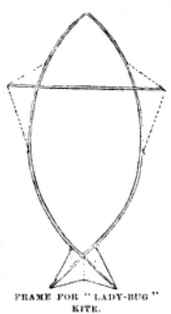
Trim the edge natly to the shape of the kite, leaving a margin of about two inches all around, then turn this margin over the strings or bamboo that outline the kite, and paste the edge down all around, taking care to leave a rim, at least the width of a straw, beyond the strings. Remember the paper must not be pasted to the interior of the frame of the kite.
Ritagliate il bordo in modo da adattarlo alla forma dell’aquilone, lasciando un margine di circa due pollici tutto intorno, quindi girate questo margine sopra le corde o il bambù che delineano l’aquilone e incollate il bordo tutto intorno, avendo cura di lasciare un bordo, largo almeno quanto una cannuccia, oltre le corde. Ricordate che la carta non deve essere incollata all’interno del telaio dell’aquilone.
Now for the decoration. Our designes include a wonderfull Chinese”dragon” kite made of red paper. The kite itself forms the dragon’s wings, and the dragon’s body can be painted on with black paint, or cut out of black paper and pasted on; or the body can be made of black worsted and gummed on, if preferred.
Passiamo ora alla decorazione. I nostri disegni includono un meraviglioso aquilone cinese “drago” fatto di carta rossa. L’aquilone stesso forma le ali del drago, mentre il corpo del drago può essere dipinto con vernice nera, o ritagliato da carta nera e incollato; oppure, se si preferisce, il corpo può essere realizzato in tessuto pettinato nero e incollato con la gomma, se lo preferite.
The “lady-bug” kite is not difficult to make. After the frame is made and covered with white paper, the head, the edges, and the little three cornered piece between the wings are to be painted black, the neck in red stripes, the wings with brown veinings, and the under wings with light gray. The antennæ can be cut out of brown paper or card, and gummed on. Then you will have an enormous lady-bug, which, when properly fitted with a kitetail, will fly away” at a fine rate. For the kite-tail, a long, slender cord, knotted every four inches into nooses, will be necessary. Slip through each noose-knot a doubled strip of paper four or five inches long. The tail should be about five times as long as the kite, for a kite three feet long, and proportionately longer as the kite is made larger, so that a kite six feet tall, which some ambitious youth may like to build, will need a tail some eighty feet long. Of course the higher the kite is to be flown the longer the tail needs to be.
L’aquilone “coccinella” non è difficile da realizzare. Dopo che la cornice è stata realizzata e ricoperta con carta bianca, la testa, i bordi e il piccolo pezzo a tre angoli tra le ali saranno dipinti di nero, il collo a strisce rosse, le ali con venature marroni e le ali inferiori con strisce chiare grigio. Le antenne possono essere ritagliate da carta o cartoncino marrone e incollate. Allora avrai un’enorme coccinella che, se adeguatamente dotata di una coda di aquilone, “volerà via” a una velocità impressionante. Per la coda di aquilone sarà necessaria una corda lunga e sottile, annodata ogni quattro pollici in cappi.
Fai passare attraverso ciascun nodo del cappio una striscia di carta doppia lunga quattro o cinque pollici. La coda dovrebbe essere circa cinque volte più lunga dell’aquilone, per un aquilone lungo tre piedi, e proporzionalmente più lunga quanto l’aquilone viene ingrandito, in modo che. un aquilone alto sei piedi, che qualche giovane ambizioso potrebbe voler costruire, avrà bisogno di una coda lunga circa ottanta piedi. Naturalmente più alto deve essere fatto volare l’aquilone, più lunga dovrà essere il codino.
The frame for the “lady-bug” kite is also adapted to the “old woman” kite. Cover the frame with white paper, and paint in green, red, yellow, and sky-blue, the figure of a good-natured old dame. Leave the apron, face, and stockings, white, paint the dress green, the hair, red, and touch up the features with black and yellow. It really seems a shame to send the old lady up aloft in windy weather, when she might catch rheumatism or toothache, but youth is inexorable, and away she goes.
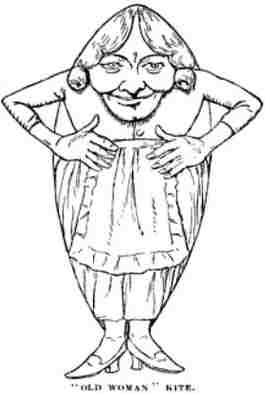
Il telaio dell’aquilone “coccinella” è adattato anche all’aquilone “old woman”. Copri la cornice con carta bianca e dipingi in verde, rosso, giallo e azzurro cielo la figura di una vecchia signora di buon carattere. Lascia il grembiule, il viso e le calze bianche, dipingi il vestito di verde, i capelli di rosso e ritocca i lineamenti di nero e giallo. Sembra davvero un peccato mandare lassù la vecchia signora quando c’è vento, quando potrebbe prenderle reumatismi o mal di denti, ma la giovinezza è inesorabile, e lei se ne va.
Miss Highflyer,” now, looks as if she might enjoy the breezy trip. The frame for this kite is not difficult to make. The cross-sticks should be securely fastened together with fine wire, and a strip of cane or bamboo bent to make an outline for the skirt, the ends being securely tied together with strong twine and fastened so they join the ends of the cross-pieces. The head is a circle of wire attached by cords to the frame, and the remainder of the frame is outlined by cords, as shown by the dotted lines. After the frame is covered with paper, the woman’s figure may be painted as illustrate, or dressed in fashionable style with bits of brown striped calico, and silk. These can be sewed on, remembering to fasten them only to the edge of the frame.
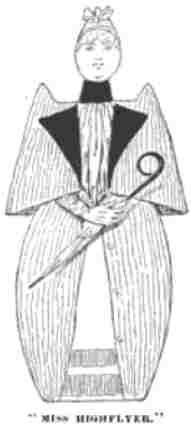
La “signorina Highflyer”, ora, ha l’aria di potersi godere il viaggio con la brezza. La struttura di questo aquilone non è difficile da realizzare. I bastoncini trasversali devono essere fissati insieme con un filo di ferro sottile e una striscia di canna o di bambù deve essere piegata in modo da formare la sagoma della gonna; le estremità devono essere legate insieme con uno spago forte e fissate in modo da unire le estremità dei bastoncini trasversali. La testa è un cerchio di filo metallico attaccato con corde al telaio, mentre il resto del telaio è delineato da corde, come mostrato dalle linee tratteggiate. Dopo aver ricoperto la cornice con la carta, la figura della donna può essere dipinta come illustrato, oppure vestita alla moda con pezzi di calico marrone a righe e seta. Questi possono essere cuciti, ricordandosi di fissarli solo al bordo della cornice.
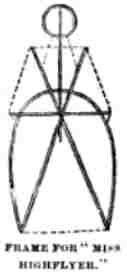
The “captive balloon” and the “Old Crow” kites are made on the same style of frame, one of the simplest, and perfhaps the best flying of all. It needs a lath about three-eighths of an inch thick, one inch and a half broad, and as many feet lomg as required: six feet is very long, three feet quite sufficient for an prdinary kite. This will form the upright, BC. Point the top, and cut a notch on each side of the lath at an inch from its top and bottom. Then take a piece of thim cane and bend it into the semicircle E. B F. with strong twine fasten it to the head of the lath, and then tie the ends together with a fine cord, from E to F, so that the head of the kitemay form an easy curve. At about one-third the distnce from the bottom of the upright, G, fasten the cords, P, Q, R, S, to E and F, and B and G; and other cords from C to F, and C to E. The frame is then complete.
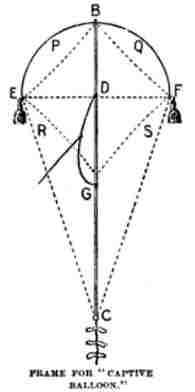
Il “pallone frenato” e l’aquilone “Old Crow” sono costruiti con lo stesso tipo di struttura, una delle più semplici e forse la migliore per volare. È necessario un listello spesso circa tre ottavi di pollice, largo un pollice e mezzo e lungo quanti piedi sono necessari: sei piedi sono molto lunghi, tre piedi sono sufficienti per un aquilone ordinario. Questo costituirà il montante, BC. Puntare la cima e fare un intaglio su ogni lato del listello a un centimetro dalla cima e dalla base. Poi prendete un pezzo di canna da zucchero e piegatelo a semicerchio E B F. Con uno spago robusto fissatelo alla testa del listello, quindi legate le estremità con un cordoncino sottile, da E a F, in modo che la testa dell’aquilone possa formare una curva facile. A circa un terzo della distanza dalla base del montante, G, fissate le corde P, Q, R, S a E e F, e B e G; altre corde da C a F, e da C a E. Il telaio è così completato.
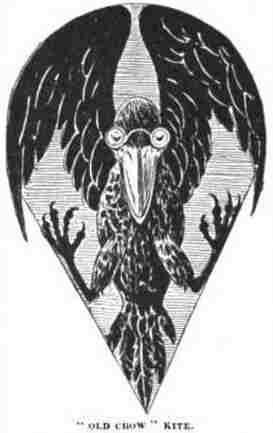
For the groteswue “Old Crow” kite, paint the paper with the kite is covered, with black and yellow paint, in a design as shown in the illustration.
The artist need not follow copy strictly, – any fancy touches which will make the moster more hideous can be thrown in at pleasure.
Per l’aquilone grottesco “Old Crow”, dipingete la carta di cui è ricoperto l’aquilone con vernice nera e gialla, in un disegno come mostrato nell’illustrazione.
Non è necessario che l’artista segua rigorosamente la copia – si possono inserire a piacere tutti i tocchi di fantasia che renderanno l’aquilone più orribile.
The “captive balloon” is made on the same frame, and can be of yellow or white paper with the design drawn on it in black, with Mr. Punch as the aeronaut, in bright red, waving a red, white, and blue flag, while poor Judt, his disconsolate spouse-cut out of cardboard, and attached by a wire-clings to the tip of the kite.
Il “pallone frenato” è realizzato sullo stesso telaio e può essere di carta gialla o bianca con il disegno disegnato sopra in nero, con Mr. Punch nei panni dell’aeronauta, in rosso brillante, che sventola una bandiera rossa, bianca e blu , mentre il povero Judt, la sua sconsolata sposa, ritagliata nel cartone e attaccata con un filo, si aggrappa alla punta dell’aquilone.
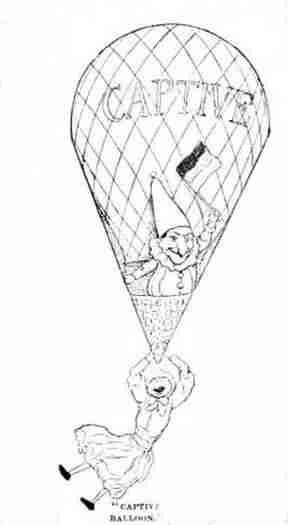
The “flying man kite is mounted on a frame made of two pieces of cane, bent in sections of a circle and tied into place by cords at the points shown by the dotted lines, two cords being required for each bent cane. The two are a then lapped and securely joined with a piece of wire. The frame then can be covered with paper upon which the comical figure of the flying man can be drawn or painted. A figure from some of the full-page cartoons of the illustrated papers can be pasted on. Without this figure, the frame covered plainly with any colored paper preferred will make a very pretty “butterfly or “moth” kite.
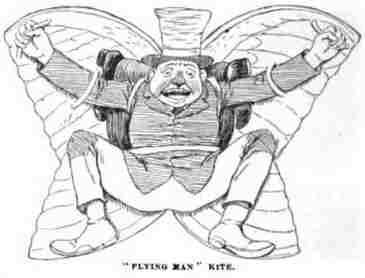
L’aquilone volante è montato su un telaio costituito da due pezzi di canna, piegati in sezioni di cerchio e legati in posizione da corde nei punti indicati dalle linee tratteggiate; sono necessarie due corde per ogni canna piegata. I due pezzi vengono poi sovrapposti e uniti saldamente con un pezzo di filo di ferro. Il telaio può essere ricoperto di carta su cui disegnare o dipingere la buffa figura dell’uomo volante. Si può incollare una figura tratta da alcune vignette a tutta pagina dei giornali illustrati. Senza questa figura, il telaio, ricoperto di carta colorata, sarà un aquilone “farfalla o falena” molto carino.
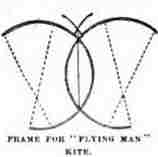
The “clown” kite is simplest of all in its construction. For the frame place two cross-pieces of wood, one a little longer than the other, at right angles, secure them with twine, carry the twine around the frame to give an outline, cover with paper, and paint the clown in blue and yellow. The hands can be cut out of pasteboard and gummed on.
L’aquilone “clown” è il più semplice di tutti nella sua costruzione. Per l’intelaiatura si mettono due pezzi di legno incrociati, uno un po’ più lungo dell’altro, ad angolo retto, si fissano con dello spago, si porta lo spago intorno all’intelaiatura per dare un contorno, si copre con della carta e si dipinge il clown in blu e giallo. Le mani possono essere ritagliate dal cartoncino e fissate con la gomma.
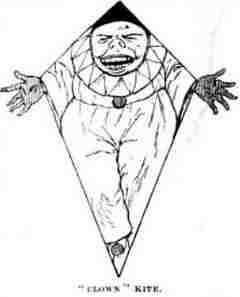
The string with which the kite is to be flown must be fastened to the belly-band of the kite. This is a cord fastened to the kite in the middie of the frame, at two points, as shown in the lettered frame of a kite, at D and G, letting the cord hang loosely in front. Tie the kite-string firmly to this cord, and the delicate machine is all ready for an upward start.
La corda con cui si farà volare l’aquilone deve essere fissata al belly-band dell’aquilone. Si tratta di una corda fissata all’aquilone nella parte centrale del telaio, in due punti, come mostrato nel telaio di un aquilone in lettere, a D e G, lasciando che la corda penda liberamente davanti. Legando saldamente la corda dell’aquilone a questa corda, la delicata macchina è pronta per la partenza verso l’alto.
Articolo tratto da Demorest’s Monthly Magazine, Volume 27
Digitalizzato in Google Libri
Link all’articolo: Raggiungere una grande altezza con gli aquiloni.